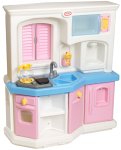Electronic Home Kitchen
Wall kitchen set.
 Fun Electronic Kitchen features pretend stove-top grill with 3 cooking sounds and light up "flames". The faucet has pretend running water sounds.
Fun Electronic Kitchen features pretend stove-top grill with 3 cooking sounds and light up "flames". The faucet has pretend running water sounds.
Advances in Dollhouse Electronics
Dollhouses have come a long way from simple playsets to highly sophisticated miniature worlds, thanks to remarkable advances in electronics and technology. These advancements have transformed traditional dollhouses into interactive and realistic environments, enhancing the play experience for children and collectors alike:
LED Lighting: One of the notable advancements in dollhouse electronics is the integration of LED lighting systems. LED lights provide realistic and adjustable illumination for each room, allowing dollhouse enthusiasts to recreate different moods and settings. Miniature chandeliers, lamps, and even fireplaces can be outfitted with LED bulbs for a lifelike glow.
Sound Effects: Dollhouses now feature sound effects that add depth and immersion to the miniature world. From the soft hum of a television to the chatter of kitchen appliances, sound effects enhance the atmosphere and make the dollhouse environment more dynamic and engaging.
Motion and Animation: Some modern dollhouses incorporate motion and animation to create captivating scenes. Miniature fans rotate, tiny figures move, and doors can automatically open and close. These animations add an interactive layer to the dollhouse's charm and surprise.
Voice Activation: With voice-activated technology, dollhouses respond to commands and prompts, creating a more interactive experience. Children can control lights, appliances, and even initiate conversations between miniature characters using voice commands.
Smartphone Integration: Dollhouses equipped with smartphone integration allow users to control various features using a mobile app. This may include adjusting lighting, activating animations, or even remotely controlling elements within the dollhouse, providing an added level of convenience and control.
Remote Control: Some dollhouses feature remote control capabilities, enabling users to adjust settings, activate animations, and manage lighting from a distance. This technology offers greater flexibility and makes it easier to customize the dollhouse's environment.
Interactive Accessories: Dollhouse electronics have expanded to include interactive accessories that respond to touch or motion. For example, miniature TVs may display changing images or scenes, and mirrors may light up to simulate real reflections.
Smart Home Integration: The concept of the smart home has extended to dollhouses, allowing users to integrate their miniature world with other smart devices. This integration can include syncing dollhouse lighting with real-world lighting or triggering actions in the dollhouse based on external events.
Customization: With advanced electronics, dollhouses can be highly customizable. Users can program and adjust various settings to create specific scenes, moods, or effects. This level of customization enables creativity to flourish and makes each dollhouse experience unique.
Learning and Education: Some electronic dollhouses offer educational features, such as interactive quizzes, trivia, or facts about the miniature world. These features blend play with learning, making the dollhouse an educational tool as well as a source of entertainment.
The evolution of dollhouse electronics has revolutionized how people engage with and enjoy miniature worlds. These technological advancements not only enhance play experiences but also allow for greater personalization, creativity, and immersion within the miniature environment.
